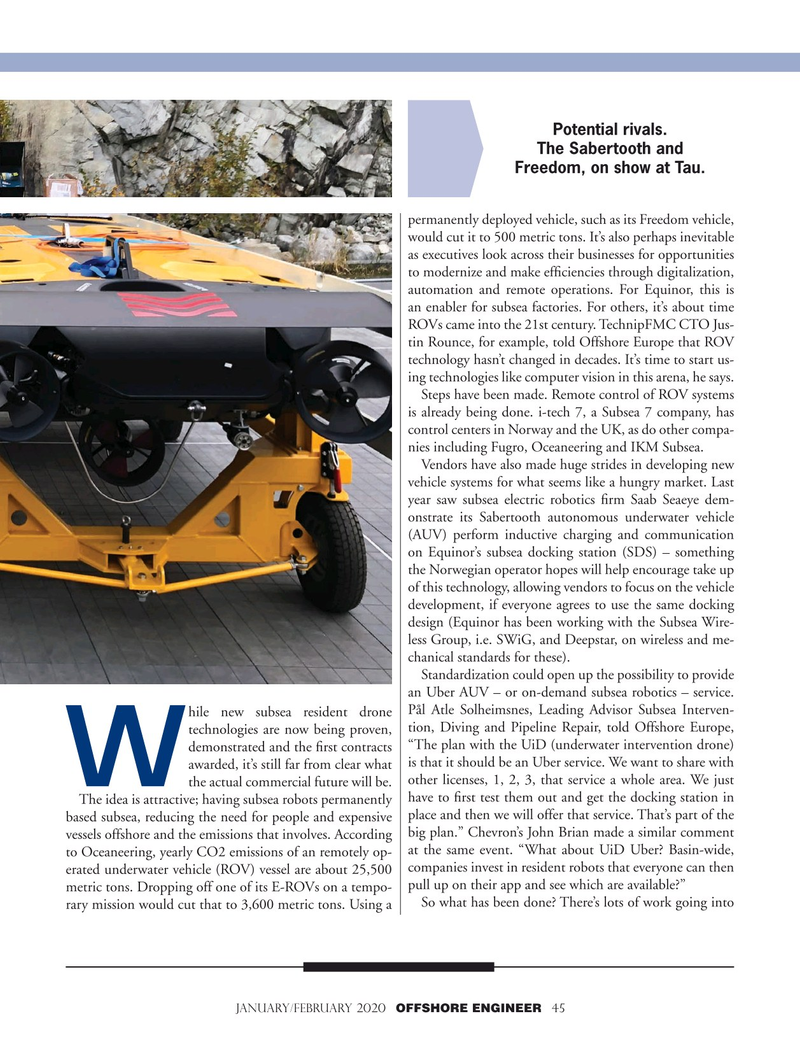
Page 45: of Offshore Engineer Magazine (Jan/Feb 2020)
Read this page in Pdf, Flash or Html5 edition of Jan/Feb 2020 Offshore Engineer Magazine
Potential rivals.
The Sabertooth and
Freedom, on show at Tau.
permanently deployed vehicle, such as its Freedom vehicle, would cut it to 500 metric tons. It’s also perhaps inevitable as executives look across their businesses for opportunities to modernize and make ef? ciencies through digitalization, automation and remote operations. For Equinor, this is an enabler for subsea factories. For others, it’s about time
ROVs came into the 21st century. TechnipFMC CTO Jus- tin Rounce, for example, told Offshore Europe that ROV technology hasn’t changed in decades. It’s time to start us- ing technologies like computer vision in this arena, he says.
Steps have been made. Remote control of ROV systems is already being done. i-tech 7, a Subsea 7 company, has control centers in Norway and the UK, as do other compa- nies including Fugro, Oceaneering and IKM Subsea.
Vendors have also made huge strides in developing new vehicle systems for what seems like a hungry market. Last year saw subsea electric robotics ? rm Saab Seaeye dem- onstrate its Sabertooth autonomous underwater vehicle (AUV) perform inductive charging and communication on Equinor’s subsea docking station (SDS) – something the Norwegian operator hopes will help encourage take up of this technology, allowing vendors to focus on the vehicle development, if everyone agrees to use the same docking design (Equinor has been working with the Subsea Wire- less Group, i.e. SWiG, and Deepstar, on wireless and me- chanical standards for these).
Standardization could open up the possibility to provide an Uber AUV – or on-demand subsea robotics – service. hile new subsea resident drone Pål Atle Solheimsnes, Leading Advisor Subsea Interven- technologies are now being proven, tion, Diving and Pipeline Repair, told Offshore Europe, demonstrated and the ? rst contracts “The plan with the UiD (underwater intervention drone) awarded, it’s still far from clear what is that it should be an Uber service. We want to share with the actual commercial future will be. other licenses, 1, 2, 3, that service a whole area. We just
W
The idea is attractive; having subsea robots permanently have to ? rst test them out and get the docking station in based subsea, reducing the need for people and expensive place and then we will offer that service. That’s part of the vessels offshore and the emissions that involves. According big plan.” Chevron’s John Brian made a similar comment at the same event. “What about UiD Uber? Basin-wide, to Oceaneering, yearly CO2 emissions of an remotely op- erated underwater vehicle (ROV) vessel are about 25,500 companies invest in resident robots that everyone can then pull up on their app and see which are available?” metric tons. Dropping off one of its E-ROVs on a tempo-
So what has been done? There’s lots of work going into rary mission would cut that to 3,600 metric tons. Using a
JANUARY/FEBRUARY 2020 OFFSHORE ENGINEER 45

 44
44

 46
46